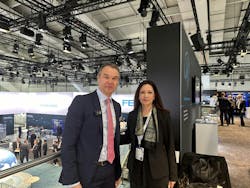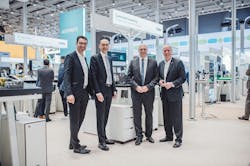Hannover Messe 2024: Festo’s Frank Notz on the State of the Automation Industry
Hydrogen, the circular economy, digitalization and sustainability were overriding topics at Hannover Messe 2024, making Festo’s press session a good foil for a snapshot of global trends.
The maker of pneumatic and electrical automation technology, which boasts more than 30,000 products and system solutions, continues to expand its portfolio by investing in digitalization and artificial intelligence. According to the company, automation technology and technical education are its two key drivers.
Business Highlights
Slightly down from the previous year, the Festo Group generated sales of €3.65 billion (about $3.9 billion) in 2023. Customers in mechanical and plant engineering erred on the side of caution in almost all sectors and regions, noted Festo, particularly in Asia and North America. The electronics industry—a strong growth driver—also stammered earlier this year after experiencing a boom in 2023.
“Last year was a difficult year,” Frank Notz, member of the Management Board Sales, Festo, told Machine Design. “We had about −4% in the top line. However, we see a quite different performance in different markets. Let me start with a geographical [overview]. China has been challenging, while North America has been really very positive for us. Mainland Europe also has some challenges—energy consumption, high energy costs, etc. That will continue, I would say, on the same scale also for this year, with some challenges in the European market. I see a very, very positive environment in North America and rest of the markets we have to deal with.”
Open Ecosystem Partnership Launched in Hannover
While Festo’s press conference at the international trade fair provided industrial journalists a high-level briefing of the company’s year in review and what’s ahead in 2024, it was also the site for announcing a major partnership with Phoenix Contact. By the end of the year, Festo will use Phoenix Contact’s PLCnext Technology, a combination of open control technology, modular engineering software and an online community that support the convergence of IT and OT—all of which align with Festo’s overall future direction.
For more detailed insights, Machine Design sat down with Notz at Festo’s booth to reflect on key issues raised during his presentation.
Machine Design: Festo’s response to global conditions is a “local for local” strategy. Where are your growth markets? What does this mean for your European market?
Frank Notz: So, we clearly have to spreadsheet local for local. And what does this mean? We want to be much closer to our customers. And not only in terms of manufacturing and logistic processes. I think this is has been around for many years, but also in terms of engineering because there are some specifics in the North American market and we want to tackle them. Therefore, we are going to invest in operations but also in R&D resources in North America. In the end, that is where the entire business is moving—towards more decentralization, closer to customers, quicker response time and closer to what is actually needed by the customers
MD: Sustainability and productivity can be thought of as two separate strategies that provide tension. From Festo’s perspective, how do you create a better world while staying competitive?
FN: You said it’s two separate elements—productivity and sustainability. I’m clearly convinced, in the long run, we have to bring it together. Because I don’t believe it is really helpful for everybody if we create a lot of productivity but, at the same time, we are not sustainable. And so, it’s clear that we have to focus on both. Now, depending on what business you are in, also depending on what environmental situation, political situation you are in, you may get a slightly different focus. But in the industry productivity has to be [prioritized] because that defines your competitiveness at the end.
And I believe that the companies that combine the productivity element and the sustainability element will be more successful. By the way, we see it already in the financial world where companies…get some benefits of that. And this is not only on the on the productivity side.
MD: Sustainability and responsible energy use has been front-and-center at Hannover Messe these past few years. What specific products/solutions did Festo bring to the Hannover showcase this year to help customers tangibly reduce energy consumption in industrial production?
FN: There are a number of very interesting innovations. Number one, we call it controlled pneumatics. What does it mean? With piezo technology we can control the pneumatic motion in an intelligent way, so we don't need all the way throughout the entire motion process the full pressure. So, we can detect that after some valves, now six bar is not required anymore, and so we can reduce the pressure. And that saves a lot of energy. That’s one element.
The other element is, we provide our customers a lot of tools to design the right products and also in terms of operating the products. And that is, I think, very simple and easy to implement elements. And then, on the long run, and we have started applying artificial intelligence, so that you get more transparency on energy consumption or predictive maintenance. And so, I think these are some good ingredients, but more to come for sure.
MD: The ideal of smart factories and smart solutions have been around for some time. What makes artificial intelligence a driving force in becoming a smart factory? Can you refer to an AI use case?
FN: Smart factory is a buzzword. And what does it mean? Customers expect a higher productivity. In order to do so you need to have full transparency. What’s going on in your, in your factory? Once you have this transparency, then you can apply very specific measures to improve. Artificial intelligence is one element. It can be based on the data collection. You can then predict, for instance, how the machine performs in this week or next week. So, you can predict maintenance issues or you can predict quality elements.
Artificial intelligence will be applied in many different directions. There are already some concrete use cases, as I mentioned, predictive maintenance and predictive quality. Now, you could say this has been around forever. Yes. But now we are entering the next level. We can draw much more benefit with higher intelligence, higher analytical skills, more computing power. I think this is one use case. The other one is in the future smart factory devices talk to each other individually. Machines talk to machines individually. So, we then have an ecosystem that is partially managing by itself.
MD: The push for open architecture was another theme at Hannover Messe 2024. From Festo’s perspective, how does open architecture support machine builders?
FN: There are two levels. Customers start from the PLC—whether they use Rockwell, which is very common in North America, or Siemens or Beckhoff. We are a component supplier, so we have to be able to connect our products to these PLCs. So that is one task. So upwards. But then, if the customer has, for instance, an open architecture component like a bus terminal, he also can expand more valve islands, more valve positions, but he also can include remote I/O elements. He can include different functions—pressure control, vacuum functions.
Also, the product itself is quite flexible for certain functions, and the machine builder can also do this later in the process. So he must not think right from the beginning what is needed. If he finds out that he needs more valve positions, he can include them later on. This is what we mean by open architecture: very flexible solutions in terms of connectivity, but also in terms of technical functionality.
MD: Festo is keen on developing future qualifications through its Didactic portfolio. The modular learning concept allows a learner to develop specialist skills in biomechatronics—combining mechanics, electrical engineering and computer science and then adding biology. How have skill sets changed in relation to technology advancements at Festo?
FN: Take myself: I’m a mechanical engineer. But we have been discussing artificial intelligence, smart components, smart factories, connectivity and so on. I think the technology is changing. Therefore, we have to upskill and skill our employees. Didactic is a very important element in this skilling process, because everybody talks about a shortage of skilled labor, because in many markets it’s a dominant element.
We, in industry, have to find a way that we train and skill our employees for future requirements. Like I said, connectivity, artificial intelligence is a different set of technology. We have also to upskill our existing workforce. We cannot only hire new people, which are, by the way not available for everybody, so that we also have a shortage there. I think the only way to go forward is to work with our people to skill them on future requirements.
MD: On a personal note, your educational background includes degrees in mechanical design and then business management at Harvard Business. You started at Festo early in your career and advanced through product management and sales management roles. If you were just starting out in engineering today, how would your path differ?
FN: I think I would go as broad as I can in terms of university degree so I would do mechanical, I would do business, I would do electrical. But that’s most likely my interest in many, many elements. Because you never know what life will bring. As I said, I am a mechanical engineer, but how often do I use my skill set? Not even 10% of my entire business life. But I think it's important. We call it lifelong learning; everybody's in that position. Stay interested and remain eager to learn about new stuff, because every day something cool is being invented. And I think this is also the beautiful thing in our industry, in our market.
Editor’s Note: Machine Design’s WISE (Workers in Science and Engineering) hub compiles our coverage of workplace issues affecting the engineering field, in addition to contributions from equity seeking groups and subject matter experts within various subdisciplines.
About the Author

Rehana Begg
Editor-in-Chief, Machine Design
As Machine Design’s content lead, Rehana Begg is tasked with elevating the voice of the design and multi-disciplinary engineer in the face of digital transformation and engineering innovation. Begg has more than 24 years of editorial experience and has spent the past decade in the trenches of industrial manufacturing, focusing on new technologies, manufacturing innovation and business. Her B2B career has taken her from corporate boardrooms to plant floors and underground mining stopes, covering everything from automation & IIoT, robotics, mechanical design and additive manufacturing to plant operations, maintenance, reliability and continuous improvement. Begg holds an MBA, a Master of Journalism degree, and a BA (Hons.) in Political Science. She is committed to lifelong learning and feeds her passion for innovation in publishing, transparent science and clear communication by attending relevant conferences and seminars/workshops.
Follow Rehana Begg via the following social media handles:
X: @rehanabegg
LinkedIn: @rehanabegg and @MachineDesign


